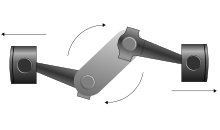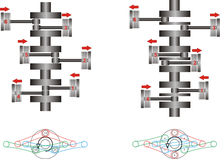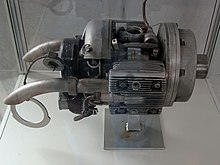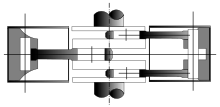Boxer engine
The boxer engine (in the German standard DIN 1940 only: boxer engine ) is a design of a multi-cylinder reciprocating piston engine that is mostly used as an internal combustion engine .
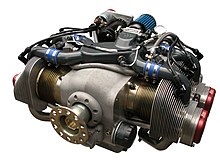
history
The boxer engine was invented by Carl Benz in 1896. Benz called it the “Contra engine” because the two cylinders were opposite one another, and built it for the first time in 1897 in the “Dos à Dos” (French: back to back) model from Benz & Cie. Rheinische Gasmotorenfabrik .
Designs
The boxer is always built with an even number of cylinders, mainly as a four-stroke engine . The cylinders or cylinder banks (with more than two cylinders) are arranged opposite one another (bank angle 180 °) and slightly offset from one another (see illustration).
- Differentiation from the V-engine
The difference to the 180 ° V-engine lies in the arrangement of the connecting rods on the crankshaft :
- In boxer engines, the connecting rods of two opposing cylinders are arranged on two crankpins offset by 180 ° . The two pistons move in opposite directions and are always mirror-inverted in the same position, for example both in top dead center .
- In the case of a V-engine, two connecting rods engage on the same crank pin, so the pistons move in the same direction. At 180 ° V-engine thus a piston each is located in the "upward movement" (when a so in compression or exhaust stroke ), the other in the "downward movement" (ie, in the suction or stroke ). Since the inertia forces of opposing pistons, unlike the boxer, do not balance each other out, this design is only useful if there are several pairs of cylinders. Well-known twelve-cylinder engines , sometimes referred to as boxers, are the engine of the Porsche 917 , as well as various Ferrari Berlinetta Boxers (in the types 365 , 512 BB and Testarossa ). Tatra used four-cylinder 180 ° V engines in the Tatra 57 in 1932 .
Advantages and disadvantages
The advantages of a boxer engine over an in- line or V-engine are in particular:
- smoother running due to better balance of inertia forces ( inertia forces) and, associated with this, comparatively smoother running,
- less mechanical stress such as tension or vibrations ,
- fewer rotating masses due to shorter crankshafts and the omission of a balance shaft that is sometimes necessary for in-line and V-engines
- flat design, which leads to a lower and therefore more favorable center of gravity of a vehicle.
The disadvantages are:
- larger number of components and production stages , which lead to higher production costs in series production;
- higher space requirements usually exclude transverse installation (crankshaft transverse to the direction of travel).
- The oil lubrication is not supported by gravity in horizontal engines. This has to be taken into account in the design, in particular because of the lateral and longitudinal accelerations, for example by using oil pumps that extract oil at critical points (cylinder head, turbocharger) or through bulkheads.
Boxer engines in road vehicles
Volkswagen cars and vans
The most popular boxer engine in the world is the air-cooled four-cylinder engine from Volkswagen , which was developed for the VW Beetle in the 1930s and was used in various versions in the VW bus until 1992 . The production of these engines ended in 2003 together with the Beetle production at Volkswagen de México . The engine is used in most trikes to date (2014).
The VW T2 bus (built in Germany from 1967 to 1979) with an air-cooled boxer engine was in production in Brazil until the end of 2005. Production until the end of production was switched to water-cooled in-line engines.
From the end of 1982 in Germany, in addition to the tried and tested air-cooled engines, water-cooled variants ("water boxers", WBX) were also installed in the VW T3 bus . The most powerful were equipped with electronic ignition and gasoline injection ( Digifant ) with catalytic converter and 95 HP (70 kW) or Digijet without catalytic converter and 112 HP (82 kW). Because of the complex routing of the water pipes between the two cylinder heads and the connection to the front radiator, these cars were more prone to failure than their air-cooled predecessors. Therefore, in 1992 - two years after the introduction of the front-wheel drive VW T4 bus - the production of VW boxer engines in Germany was discontinued after more than 50 years.
Other vehicle manufacturers
The British manufacturer Jowett Cars Ltd. in Bradford , built two-cylinder boxer engines with 815 cm³, from 1935 four-cylinder boxer engines and in 1947 a new four-cylinder boxer engine with 1.5 liter displacement in its vehicles. All engines were water-cooled.

Subaru and Porsche use water-cooled boxer engines as standard . The Subaru boxers were also used on the Subaru derivative Saab 9-2X . Subaru has been building the first boxer diesel engine with common rail injection and turbocharging since 2008 .
Other vehicle manufacturers experimented with boxer engines. The Czech automobile manufacturer Tatra built air-cooled two-, four- and eight-cylinder engines for passenger cars. They were commonly referred to as boxers, but the four-cylinder were 180 ° V engines.
The Citroën 2CV ("duck") and the models derived from it had air-cooled two-cylinder boxers. This also applies to the Dutch DAF 600 cars and their successors, which were known for their continuously variable “ Variomatic ” transmission. The small car models from the Puch-Werke ( Puch 500/650 ), which achieved success in motorsport in the 1960s , and the Puch Haflinger off-road vehicle were also equipped with air-cooled two-cylinder boxer engines, as were the vehicles from the French manufacturer Panhard , which consisted of a one-liter Two-cylinder boxer engines drew up to 70 hp (51 kW). The small cars BMW 600 and BMW 700 had a fan-cooled two - cylinder boxer engine with a light alloy crankcase derived from the motorcycle .
The Borgward group had been in the late 1950s for their model ranges Goliath 1100 /1100 and Hansa Lloyd Arabella 1100 and 900 cc, water-cooled four-cylinder boxer engines with aluminum pistons, -Köpfen and enclosures in serial production. The Citroën GS had a modern, air-cooled four-cylinder boxer engine with overhead camshafts. The four and six cylinder engines from Porsche from the types 356 and 911 (the latter air-cooled until 1998) are known.
The American Chevrolet Corvair had a six-cylinder boxer engine in the rear, initially with 2300 cm³ displacement, later with 2400 and 2700 cm³. There were turbo versions of the 2.4 and 2.7 liter engines; the last of these developed with a 2.9-liter engine up to 132 kW (180 hp).
Alfa Romeo used boxer engines from the early 1970s to the late 1990s in its Alfasud , 33 , Arna , 145 and 146 models . Lancia used water-cooled four-cylinder boxer engines from 1960 to 1984 in the front-wheel drive vehicles Lancia Flavia , Lancia 2000 and Lancia Gamma , a total production of over 110,000 passenger cars.
The Porsche 904 to 910 racing cars used in the 1960s had eight-cylinder boxer engines. Twelve-cylinders were also implemented, but mostly only for racing purposes. As a rule, however, these engines are not real boxer engines, but 180 ° V engines, such as in the Porsche 917 , Ferrari 512 BB and Testarossa .
motorcycles
After various smaller manufacturers, BMW in particular began to manufacture large numbers of boxer engines for motorcycles in 1923. After a built-in boxer engine for the Victoria works in Nuremberg, which was based heavily on the model of the English Douglas , the BMW R 32 was born . the first standard BMW motorcycle with a boxer engine.
The world's most popular boxer motorcycle engine is the side-steered 750 series BMW boxer engine of the BMW R 71 built from 1938 to 1941 . After production ended in Germany, it was rebuilt in Russia as an engine for the M72 sidecar motorcycle and later further developed for the vehicles of the Russian motorcycle brands Dnepr and Ural . The largely unchanged side-controlled R-71 engine has been reproduced by the Chinese manufacturer Chang-Jiang since 1957 until today (2015).
During the Second World War, Zündapp manufactured the KS 750 combination with a two-cylinder four-stroke engine, the cylinders of which are arranged in a 170-degree position. Although each piston has its own crank pin, it is a V-type engine; However, because this is almost as flat as a boxer engine, it is often - technically incorrectly - referred to as such. After the war, Zündapp built the legendary "green elephant" KS 601 with a two-cylinder boxer engine.
DKW also began developing a two-stroke twin-cylinder boxer engine during World War II . After the war, these 350 cc engines with 15 (later 17) hp rolled off the assembly line in motorcycles that could be tensioned, initially under the name IFA BK 350, and later as the MZ BK 350 until 1959.
Since 1974, Honda has been producing water-cooled four-cylinder engines in large numbers for the Gold Wing model , and then six-cylinder boxer engines from 1988 onwards.
Aircraft
Aircraft engines
In single-engine aircraft , the air-cooled boxer engine is the most frequently used drive, among other things because of the good cooling of the two cylinder banks lying in the air flow and the low overall height. Manufacturers are for example Lycoming , Rotax and Limbach .
Porsche also manufactured boxer engines for small aircraft . As early as 1943, the Porsche design office equipped a motor glider with a 33 hp VW engine, which was installed in the fuselage behind the pilot's cockpit and helped the small aircraft to reach a top speed of 140 km / h. In 1959, Porsche showed aircraft engines based on the Porsche 356 at the German Industrial Fair in Hanover . These four-cylinder boxer engines with the type number 678 had a displacement of 1582 cm³ and, depending on the version, made 50 to 75 hp. Unlike the sports car engine , they had double ignition with two spark plugs per cylinder and dry sump lubrication . The engines were air-cooled, depending on the version, either by airflow or by a fan. From September 1983 to 1990 the Porsche 911-derived six-cylinder boxer aircraft engine PFM 3200 was offered.
Starter motor for jet engines
During the Second World War, boxer engines were used as starter motors for the first German jet engines to bring the engine up to starting speed. The by Norbert Riedel developed two-cylinder two-stroke -Boxermotor "Riedel-starter" had a capacity of 270 cm³ and a power of 8 kW (10.5 HP) at 7150 min -1 . It was designed as an extremely short stroke ( bore / stroke : 70 mm / 35 mm = 2: 1) so that it would fit into the hub of the turbine compressor, and was started electrically or with a pull starter. The engine was produced by the Victoria works in Nuremberg and served as a starter for the Junkers Jumo 004 and BMW 003 jet engines .
Other areas of application
Dieter König in Berlin built successful two-stroke boxer outboard motors for racing boats from the 1960s . Boxer engines are sometimes also used in motor sports , as industrial engines to drive fire pumps , combine harvesters or as auxiliary drives in trolleybuses .
Special designs
Inline boxer engine
The inline boxer engine consists of two cylinders that are opposite each other in a line. One piston is conventionally connected to the crankshaft via a connecting rod, the second piston (on the right in the picture) via a tandem connecting rod. The crankshaft is cranked three times. Thanks to this design, the inline boxer engine hardly causes any vibrations because the mass balance is optimal. The crankshaft is very short, which means that the overall length is short. At the beginning of the 1990s, professors and diploma students from the Bingen University of Applied Sciences successfully tested this construction method on the test bench and in road tests.
Three-cylinder boxer engine
The English motorcycle manufacturer Humber Motorcycles developed a three-cylinder boxer engine with 750 cm³ displacement in 1913. The engine had a cylinder with a 78 mm bore and 78 mm stroke, the other two cylinders had 55 mm bore with the same stroke. The crankshaft had three cranks, whereby the connecting rods of the small cylinders to the left and right of the large cylinder were connected to the crankshaft. The small cylinders shared a common combustion chamber . This engine was installed in some cars with three-speed transmission and chain drive.
literature
- Jan Drummans: The car and its technology. 1st edition, Motorbuchverlag, Stuttgart 1992, ISBN 3-613-01288-X .
- Hans Jörg Leyhausen: The master's examination in the automotive trade part 1. 12th edition, Vogel Buchverlag, Würzburg 1991, ISBN 3-8023-0857-3 .
- Peter A. Wellers, Hermann Strobel, Erich Auch-Schwelk: Vehicle technology expertise. 5th edition, Holland + Josenhans Verlag, Stuttgart 1997, ISBN 3-7782-3520-6 .
- Richard van Basshuysen, Fred Schäfer: Handbook Internal Combustion Engine Basics, Components, Systems, Perspectives. 3rd edition, Friedrich Vieweg & Sohn Verlag / GWV Fachverlage GmbH, Wiesbaden 2005, ISBN 3-528-23933-6 .
Web links
Individual evidence
- ↑ Thomas Wasserbäch, Thomas Brandl, Ralf Schmidt: The six-cylinder boxer engines in the Porsche 911 . In: MTZ . Springer Vieweg, Springer Fachmedien, July 1, 2019, ISSN 0024-8525 , p. 16-24 .
- ↑ Diesel boxer engine from Subaru on gelaendewagen.at
- ↑ List of components for type Tatra 57 . Tatra-Werke Automobil- und Waggonbau AG, Kopřivnice (Moravia, Czechoslovakia). 5th edition February 1936 . Retrieved July 24, 2014.
- ↑ Consumer's Guide (editor): Encyclopedia of American Cars from 1930 . Publications International 1993. ISBN 0-7853-0175-5
- ↑ Boxer engines in comparison - the fascination of flat engines , at auto-motor-und-sport.de, accessed on March 23, 2014
- ↑ Information on the inline boxer engine at www.boxermotor.com
- ^ Humber: Motorcycles . Grace's Guide. Chronicle (English) with references to the Humber three-cylinder boxer (see 1913). Retrieved July 15, 2014.
